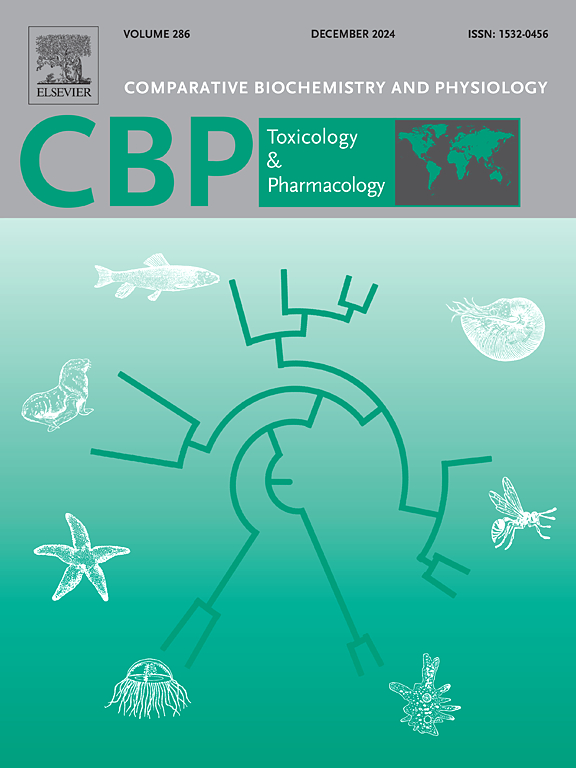Deficiency of PvDRAM2 increased the nitrite sensitivity of Pacific white shrimp (Penaeus vannamei) by inhibiting autophagy
IF 3.9
3区 环境科学与生态学
Q2 BIOCHEMISTRY & MOLECULAR BIOLOGY
Comparative Biochemistry and Physiology C-toxicology & Pharmacology
Pub Date : 2024-11-05
DOI:10.1016/j.cbpc.2024.110068
引用次数: 0
Abstract
Autophagy is an essential response mechanism to environmental stress during the evolution of organisms. DRAM2 (Damage-regulated autophagy regulator 2) is recognized as necessary for the process of p53-mediated cell apoptosis. Although the role of DRAM2 in apoptosis has been confirmed, the mechanism of its relationship with autophagy is still unclear. Here we describe PvDRAM2 features and functions. We found that nitrite stress induced autophagy accumulation and ROS production. A novel DRAM-homologous protein, DRAM2, was cloned, and its expression is significantly up-regulated under nitrite stress conditions. PvDRAM2 primarily localizes within the cytoplasmic lysosome.Loss of PvDRAM2 increased sensitivity response to nitrite stress of Pacific white shrimp. And silenced of PvDRAM2 promoted ROS production and inhibited autophagy accumulation. In addition, silenced of PvDRAM2 decreased the autophagy-related protein of p62, Beclin 1, and LC3 expression under nitrite stress of Pacific white shrimp. Collectively, these studies uncover a novel critical role for PvDRAM2 in regulating autophagy under nitrite stress. Specifically, PvDRAM2 is essential for the induction of autophagy, enabling Pacific white shrimp to adapt to environmental stress. This provides mechanistic insight into how autophagy functions as a way for Pacific white shrimp to cope with environmental challenges.
缺乏 PvDRAM2 会抑制自噬,从而增加太平洋白对虾(Penaeus vannamei)对亚硝酸盐的敏感性。
自噬是生物进化过程中对环境压力的一种基本反应机制。DRAM2(损伤调控自噬调节因子 2)被认为是 p53 介导的细胞凋亡过程所必需的。尽管 DRAM2 在细胞凋亡中的作用已被证实,但其与自噬的关系机制仍不清楚。在此,我们描述了 PvDRAM2 的特征和功能。我们发现亚硝酸盐应激会诱导自噬积累和 ROS 生成。我们克隆了一种新的 DRAM 同源蛋白 DRAM2,它的表达在亚硝酸盐胁迫条件下显著上调。PvDRAM2主要定位于细胞质溶酶体内。沉默 PvDRAM2 会促进 ROS 的产生并抑制自噬的积累。此外,在亚硝酸盐胁迫下,沉默的PvDRAM2会降低自噬相关蛋白p62、Beclin 1和LC3的表达。总之,这些研究发现了PvDRAM2在亚硝酸盐胁迫下调节自噬的新的关键作用。具体来说,PvDRAM2 是诱导自噬的关键,使太平洋白对虾能够适应环境胁迫。这从机理上揭示了自噬如何作为太平洋白对虾应对环境挑战的一种方式。
本文章由计算机程序翻译,如有差异,请以英文原文为准。
求助全文
约1分钟内获得全文
求助全文
来源期刊
CiteScore
7.50
自引率
5.10%
发文量
206
审稿时长
30 days
期刊介绍:
Part C: Toxicology and Pharmacology. This journal is concerned with chemical and drug action at different levels of organization, biotransformation of xenobiotics, mechanisms of toxicity, including reactive oxygen species and carcinogenesis, endocrine disruptors, natural products chemistry, and signal transduction with a molecular approach to these fields.

 求助内容:
求助内容: 应助结果提醒方式:
应助结果提醒方式:


